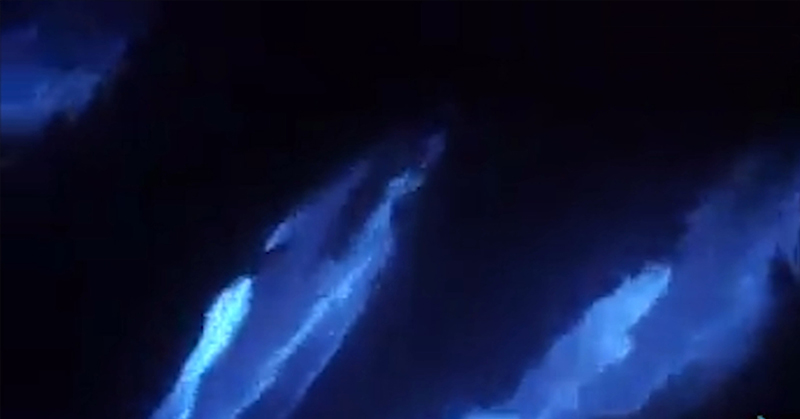Witnessing an entire pod of dolphins is, for most of us, a once-in-a-lifetime experience. Imagine, then, if you saw one swimming below the water’s surface, and they were ‘glowing‘.
This may sound like the stuff of science fiction novels, but one man recently witnessed exactly that- and has some incredible footage to prove it.
Bioluminescent Waves
Patrick Coyne shared the video he captured of the pod of dolphins that appeared to be glowing neon blue on Instagram. It is not, however, the dolphins themselves that are glowing, but rather the ocean water [1].
This glowing blue water spans about 28 kilometers (17 miles) along the coast of California, but scientists aren’t sure how long this phenomenon will last. It is caused by a microorganism in the water called dinoflagellates, that glows in order to defend itself from predators.
“The algae makes a light when a fish or little shrimp tries to eat it,” says Dimitri Deheyn, a Scripps Oceanography research scientist. “That light attracts a bigger fish that can eat whatever is trying to eat the algae” [2].
This event, which hasn’t occurred since 2013, is also known as the “red tide”, because during the day the microorganisms make the water look slightly red, while at night they glow in areas where they are disturbed by waves [2].
Read: Dozens of Creatures Thought to Be Extinct Found Alive in ‘Lost City’ in the Jungle
What Makes the Plankton Glow?
There are many marine organisms that produce light. Certain fish dangle a glowing light in front of them to attract prey, and some squid shoot out bioluminescent liquid instead of ink to confuse predators. Other organisms glow to attract a mate [3].
Species that are able to glow contain a molecule called luciferin, which produces light when it reacts with oxygen. The types of luciferin present will vary depending on the animal, and many of them also produce luciferase, which acts as a catalyst to speed up the reaction.
Animals can control when they light up in accordance with their needs, for example, if they are looking for a meal or a mate. Some can create a sort of bioluminescence bomb by bundling luciferin and oxygen together into a “photoprotein”, and many can even choose the intensity or the color of the light they produce.
There are thousands of species that have bioluminescence capabilities, however, there are also some that actually take in bacteria or other bioluminescent creatures in order to light up. Most of the light produced through bioluminescence in the ocean appears to be blue-green in colour because they have shorter wavelengths of light. Light doesn’t travel through water as easily, which is why colors with shorter wavelengths are more common [3].
In the deep sea, many animals are red. This is because red has a very long wavelength, and therefore cannot be seen in the depths of the ocean, rendering those animals invisible. There are some creatures, however, that have evolved to be able to both emit and see red light, such as the dragon fish [3].
Read: Blue Whales Have ‘Unprecedented’ Bounce Back From Brink Of Extinction
Why Do Some Creatures Glow?
There are many purposes to bioluminescence. One is to help the creature attract or find prey. An animal may cause part of their body to glow in order to attract a food source to swim near them, or some may use their glowing light to give them better visibility and allow them to find their next meal.
Another reason for bioluminescence is to attract a mate. Some use their different colors to distinguish between males and females, and others use them to communicate with a potential mate.
Finally, many organisms use bioluminescence as a form of protection. A strong or bright flash of light can scare off a predator, or at least distract and confuse them long enough to make an escape. This flashing of light could also act as an alarm, as is the case with the dinoflagellates, and attract larger predators that could scare off their attackers [3].
See it While You Can
Scientists are not sure how long this phenomenon will last, so if you live in the Newport Beach area, you should try to see it while you still can. Scripps Oceanography has said that the best time to see the glowing waters is from a dark beach, at least two hours after sunset [2].
Newport Beach isn’t the only place in the world that ‘glows’ either. Glowing Beaches in the Maldives are a world attraction. In fact, its number 7 on this list of 21 Unbelievable Places That Look Like They’re From Another Planet.

